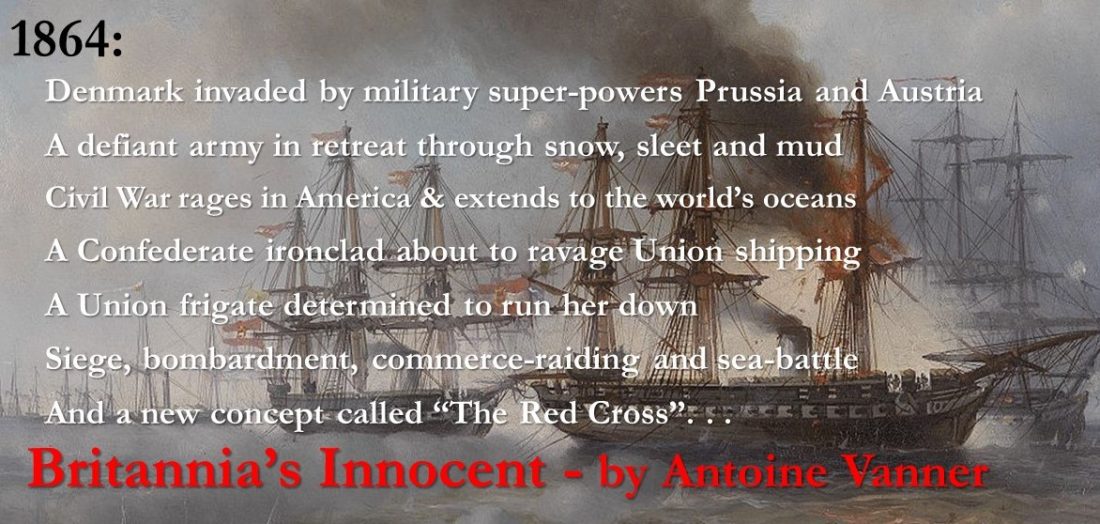The US Navy’s Sumatran Expeditions of 1832 & 1838
The US Navy’s role in the suppression of Barbary piracy in the Mediterranean is deservedly well known but few today are aware that in the 1830s two American expeditions were launched against pirates in what is now Indonesia. The scene was to be the then semi-independent Sultanate of Aceh (Atjeh in Dutch) in Sumatra and the interventions were to be the precursor to an intense and bloody series of conflicts from 1873 to 1914 in which the Netherlands’ colonial army struggled to bring the area under Dutch rule. (A previous article describes the beginning of those wars – click here to read if you have missed it). This present article is focussed on the US Navy’s Sumatran Expeditions of 1832 & 1838.

Salem in the 1830s – the base for Peabody’s shipping empire
European spheres of influence in South East Asia were still fluid in the early 1830s. Britain had taken its first steps to control of Malaya by creating the “Straits Settlements” of Penang, Singapore and Malacca in the 1820s. Lying directly to their west was the gigantic island of Sumatra. Though part of the “East Indies”, which were for the Dutch as the most important part of their overseas empire, Dutch power in Sumatra was still limited and would be so for decades to come. The Aceh sultanate in the island’s north was to all practical purposes an independent entity and free to engage with trade with all comers. Among these latter were American traders, who were building up a great commercial and shipping empire in the Far East. One of the most prominent of these was Joseph Peabody (1757 –1844) of Salem, Massachusetts. Beginning his seagoing career on privateers during the American War of Independence, he was to establish himself as a major ship-owner, building as many as 83 ships during his career and achieving great wealth in the process.
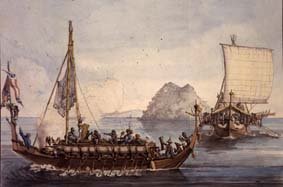
Pirate vessels of the East Indies
Ache’s most valuable trading commodity was pepper – a commodity high in value for a small volume – and it was pepper that brought Peabody’s trading vessel Friendship to the Sumatra’s North West coast, close to the settlement of Kuala Batee, in February 1831. The area was under the control of several local chieftains who appear to have had loose but cordial contacts with the sultanate. The Friendship’s captain, Charles Endicott, landed with a small group of sailors on 7th February to bargain for pepper. While this party was on shore a group of local thugs in small prahus – outrigger sailing craft – boarded the Friendship, killed the first officer and two of the crew members and captured the ship. Four other men escaped from the Friendship by swimming two miles down the coast and hiding in the forest.
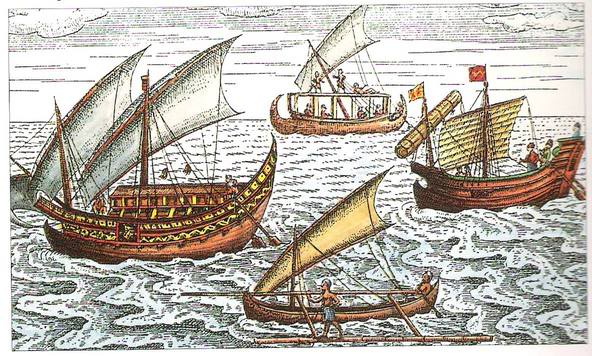
Typical Malay vessels of the time
With the support of a local leader called Pak Adam, Captain Endicott managed to make contact with three other American trading vessels in the area, the James Monroe, the Governor Endicott and the Palmer. All carried guns – a necessity in this pirate-infested area – and the Friendship was recovered only after the criminals leapt overboard and when fire had been opened on the nearby village.
The Friendship’s return to Salem with news of the outrage aroused widespread anger – the more so since this was during the presidency of Andrew Jackson, not a man uninclined to accept insult or injury meekly. The upshot was that orders were sent to Commodore John Downes, captain of the American frigate USS Potomac, then cruising off Brazil. He was to proceed to Kuala Batee, assess the situation and take any measures he deemed necessary to ensure the future safety of American traders in the area. This was the start of what became known as “The First Sumatran Expedition”.
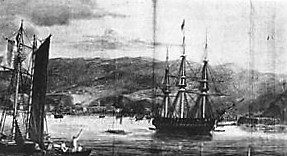
The USS Potomac – she was to see service through the Civil War
Like other “frigates” of the US Navy in the early 19th century the USS Potomac, completed in 1831, was more heavily armed than any European vessel of the same designation. Her 32 carronades and 35 long guns (including two bow and three stern-chasers) gave her fearsome firepower for her size. Her crew of 480 – trained as were all crews of the era in the use of cutlass and small arms – added the potential of a powerful landing force.
The USS Potomac arrived off Kuala Batee in early February 1832, almost an exact year since the Friendship’s ordeal. Downes disguised his ship as a Dutch merchant vessel, with her guns pulled back behind the decks and all ports shut. Unsuspecting locals came on board and, when questioned about the village’s defences, provided useful information. The attack that followed commenced at dawn on 6th February 1832 with a bombardment to cover landing of 282 American marines and seamen to the north of the settlement. Several “forts” – small stockades – were damaged by naval gunfire and stormed. By midday the Sumatran defenders had retreated inland, leaving the Americans to burn buildings and boats in reprisal. American losses amounted to two killed and some half-dozen wounded while somewhere between 80 and 100 (estimates differ) Sumatrans were killed and many more wounded. Honour had been satisfied. The American force withdrew to the USS Potomac, remained offshore for several days and thereafter set sail for the United States, circumnavigating the globe in the process.
 A Sumatran woman helping to defend her husband – perhaps against Corporal John L. Dubois
A Sumatran woman helping to defend her husband – perhaps against Corporal John L. Dubois
By the time the Potomac returned much righteous indignation has been directed at Commodore Downes and his officers. One of them, a Jeremiah Reynolds, who had been on board the Potomac as Downes’ secretary, published a book on the subject in 1835 from the perspective of those actually present and noted that “vague rumours and partial statements” in the media had created an “unfavourable prejudice in the public mind”. News of the action reached the United States by other ships prior to the USS Potomac’s return and a portion of the population – who had not been there and who knew of the incident only by hearsay – were immediately outraged by reports of collateral casualties. Women and children had indeed died, but it was not always obvious that they were non-combatants. The first report appeared on 7 July 1832, the New York Observer, an abolitionist, anti-slavery newspaper. It mentioned that “There were several women killed who had the hardihood to take up arms when they saw their husbands fall at their feet; indeed it was impossible to distinguish the sex, they dress so much alike”. It stated further in the article that “John L. Dubois, ships corporal . . . . . was wounded by a Malay woman in attacking the forts. This woman was with an Indian, probably her husband, who was attacked and killed by Dubois. As soon as she saw her husband fall, she had the courage to revenge him by attacking Dubois with a sabre; she cut him very badly between the upper joint of the thumb and where the wrist meets; the blow would have taken off the hand had it not been retarded by the barrel of the musket which was held at the time of a charge.”
The controversy simmered for a few years more but was overtaken by further events that were calculated to reduce sympathy for the Sumatrans. This was in August 1838 when another American ship, the Eclipse, was boarded at a village called Muckie by 24 Sumatrans who ostensibly wanted to trade. They were allowed on board on the condition of handing over their weapons but once trust had been established these were – unwisely – returned. The crew was then attacked and butchered, even those men who jumped into the water to escape being run down and murdered.
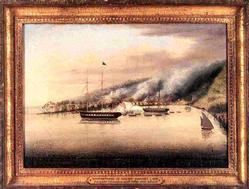
USS Columbia and USS John Adams bombarding Muckie
The American response was robust. News reached Commodore George C. Read in the Indian Ocean where, with two powerful frigates, USS Columbia and USS John Adams. He was involved with a circumnavigation associated with the United States Exploring Expedition of 1838 to 1842. He immediately diverted to Sumatra. At Muckie he landed some 360 men under cover of a bombardment. Most of the inhabitants fled and the few who resisted were silenced. The village was set ablaze and Reade withdrew his force.
This was the end of the Second Sumatran Expedition by the US Navy. A dose of bitter medicine had been administered and no further American trading ships were attacked off Sumatra thereafter. For the Dutch however a long war awaited them there in the future – but that’s a different story.
Start the Dawlish Chronicles series of naval adventures with the earliest chronologically:
Britannia’s Innocent
For more details regarding purchase in paperback or Kindle format, click below Note that Kindle Unlimited subscribers can read at no extra charge
The Dawlish Chronicles – now up to nine volumes, and counting, Click on the banner below for details. 
Six free short stories are available for download to your Kindle. Access them by registering for the Dawlish Chronicles mailing list – just click on the banner below. You’ll be kept updated on new books and will receive other free stories at intervals.


